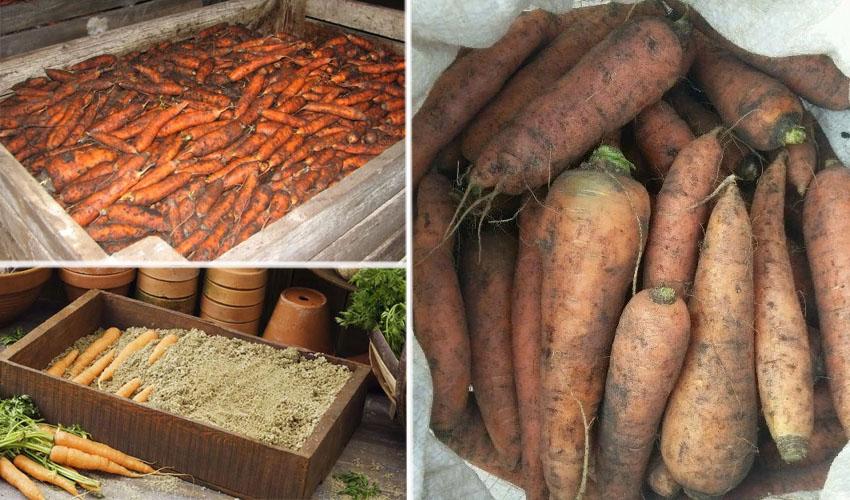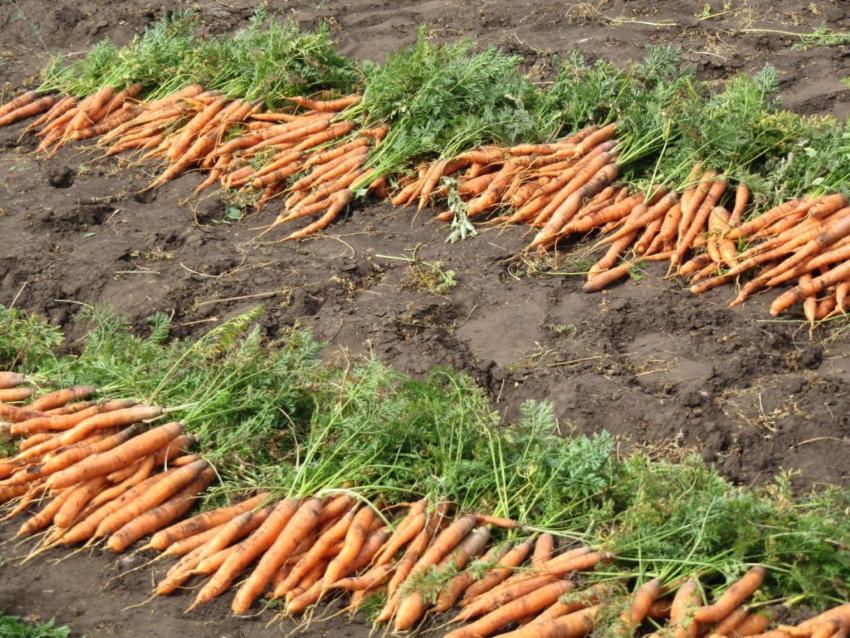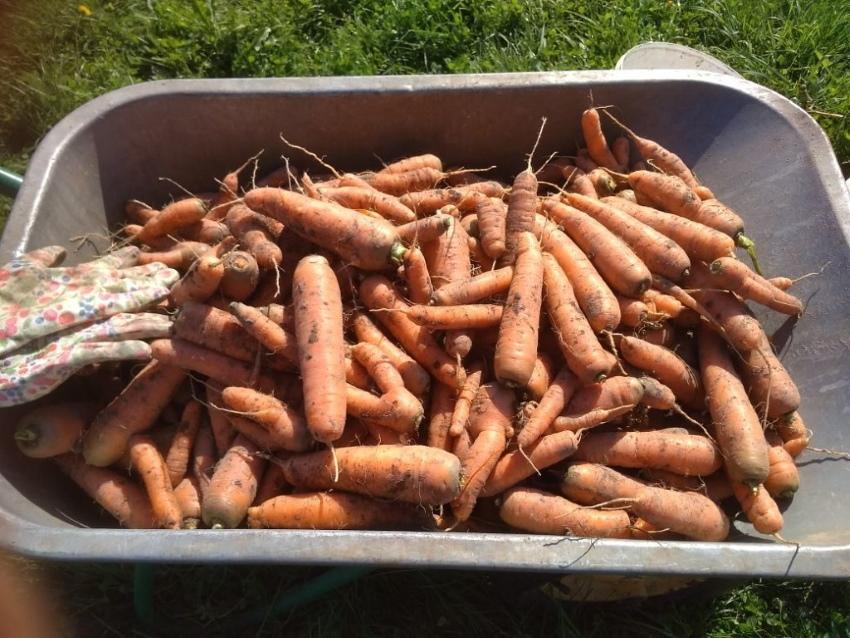How to store carrots until spring - reliable ways not to lose a rich harvest
 As you know, growing carrots is half the battle, it is equally important to preserve the harvest. You can't put much in the refrigerator, and it takes up a lot of space in the cellar, and besides, it can begin to germinate or rot. But if you know how to keep carrots in the ground until spring, then you can save the fruits and save space in the basement. This is undoubtedly the main advantage of the "earth method". Sometimes, in a particularly fruitful year, you do not know what to do with the products obtained by your hard work. In addition, by leaving carrots in the ground for the winter, you save not only space, but also your time that needs to be spent on cleaning.
As you know, growing carrots is half the battle, it is equally important to preserve the harvest. You can't put much in the refrigerator, and it takes up a lot of space in the cellar, and besides, it can begin to germinate or rot. But if you know how to keep carrots in the ground until spring, then you can save the fruits and save space in the basement. This is undoubtedly the main advantage of the "earth method". Sometimes, in a particularly fruitful year, you do not know what to do with the products obtained by your hard work. In addition, by leaving carrots in the ground for the winter, you save not only space, but also your time that needs to be spent on cleaning.
Of course, storage in the ground is possible only if you live in a private house and have a free area. But many townspeople also strive to make vegetable stocks for the winter, but this method does not suit them. It doesn't matter, because even in modest apartment conditions you can find a place and save even a few buckets of juicy root crops.
And one more important nuance: the shelf life and quality of vegetables depend on the timeliness of the harvest. It is important to dig up the carrots on time, not earlier or later than the due date. Then it will lie for a long time and remain juicy. When this can be done and how to preserve the harvest in winter, and will be discussed today.
When to dig carrots

On the other hand, you shouldn't overdo the carrot beds either. Then there will be an excess of sugar, which is immediately "pecked" by various pests. So there is a risk of sending vegetables for storage along with a carrot fly. They will also become a tasty bait for rats and mice. They also love to taste the sweet orange pulp.
Even at the stage of purchasing seeds, pay attention to the timing of the ripening of the crop. They differ significantly in early and late varieties. Although the culture itself will tell you when to start digging. After the underground part of the plant matures, the aboveground one begins to gradually die off. Yellowing of the lower leaves will be a signal for harvesting.
How to prepare vegetables for storage
 Do not rush to immediately hide the carrots in the cellar - it must go through the preparation process, namely:
Do not rush to immediately hide the carrots in the cellar - it must go through the preparation process, namely:
- Cut off the tops.
- Go through and separately fold fruits tainted by pests or accidentally damaged during digging. They are not suitable for storage, but in the kitchen they can still be used after pruning.
- Spread the carrots in one layer and let air out.
- Then keep the fruits cool for up to 2 weeks (about 10 ° C).If you missed some spoiled vegetables in the selection process, during this time they will "show themselves".
Re-sort the vegetables just before going to storage.
How to store carrots
The roots have been dug up, sorted and dried - it's time to start storing them. There are many ways to make vitamin stores and provide yourself with vegetables for the whole winter. It all depends on where exactly they will lie. And already, based on this, there are certain recommendations for storage conditions.
So, you can use the following places to store carrots:
- fridge;
- basement or cellar;
- the ground.
How to store carrots in the refrigerator
 No matter how good the refrigerator is, fresh vegetables will not be able to lie in it for a long time and will still start to deteriorate. But the freezer is a great place with optimal conditions. Therefore, for an apartment, the best way is to freeze carrots. Wash it, peel and grate or cut. Divide into bags and place in the freezer. It is better to take small packages, then it will be very convenient to use the blank one or two times.
No matter how good the refrigerator is, fresh vegetables will not be able to lie in it for a long time and will still start to deteriorate. But the freezer is a great place with optimal conditions. Therefore, for an apartment, the best way is to freeze carrots. Wash it, peel and grate or cut. Divide into bags and place in the freezer. It is better to take small packages, then it will be very convenient to use the blank one or two times.
How to store carrots in the cellar (basement) in winter
A high level of humidity and coolness in a cellar or basement is just what vegetables need for excellent keeping quality. To preserve them until the next harvest, the carrots are sprinkled with natural materials, namely:
- sawdust;
- sand;
- clay;
- moss;
- onion peel.
These methods can also be used at home (meaning apartment). Instead of a basement, in this case, there will be a balcony or loggia, provided that you have them insulated, but in winter it is not hot there. Of course, humidity is a little problematic, but a low temperature is provided. The vegetables are unlikely to stay all winter, but they will be able to for a couple of months.
In addition, you can also store carrots in cool rooms using special containers or devices:
- large enameled pots;
- plastic bags or large bags;
- cling film.
Let's consider each method in more detail.
Sawdust
 Prepare clean boxes, cardboard or plastic, only so that there are no holes, especially large ones. Pour a layer of sawdust on the bottom, lay the fruits on top, fill the sawdust again. Continue filling the container by pouring in the carrots. The top layer should be sawdust. They maintain moisture, vegetables remain firm, but do not germinate.
Prepare clean boxes, cardboard or plastic, only so that there are no holes, especially large ones. Pour a layer of sawdust on the bottom, lay the fruits on top, fill the sawdust again. Continue filling the container by pouring in the carrots. The top layer should be sawdust. They maintain moisture, vegetables remain firm, but do not germinate.
Remove sawdust from conifers if possible. Such material contains phytoncides that will not give a chance to fungus and other diseases.
Sand
 Similar to the sawdust method, put the carrots in boxes, sprinkling them with layers of sand at least 3 cm thick. It should completely cover the previous row of root vegetables. It is better to use sand that is loamy and wet, then the fruits will not evaporate their own moisture so quickly. In addition, the sand will maintain the temperature inside the box and prevent rotting.
Similar to the sawdust method, put the carrots in boxes, sprinkling them with layers of sand at least 3 cm thick. It should completely cover the previous row of root vegetables. It is better to use sand that is loamy and wet, then the fruits will not evaporate their own moisture so quickly. In addition, the sand will maintain the temperature inside the box and prevent rotting.
Old buckets will work instead of boxes.
Clay
 To book carrots for storage, the clay should be soaked in advance and a solution should be prepared. It should be liquid enough, like sour cream, but so that it cannot drain quickly. First, fill the dry clay with water and leave it for a day to soak. Stir the next day, add more water - there should be a layer of water 2 cm thick on top.Let it stand for another 3 days.
To book carrots for storage, the clay should be soaked in advance and a solution should be prepared. It should be liquid enough, like sour cream, but so that it cannot drain quickly. First, fill the dry clay with water and leave it for a day to soak. Stir the next day, add more water - there should be a layer of water 2 cm thick on top.Let it stand for another 3 days.
You can process carrots with clay mass in two ways to choose from:
- Place the fruits in a drawer, cover with clay and let dry. Place the second row of carrots and cover again with clay. Repeat until you reach the top of the box.
- Dip each root vegetable in liquid clay and let dry to form a crust. Then just put it in any container and lower it into the cellar.
In the second case, before creating a clay crust, it is advisable to first treat the carrots with a garlic solution. Dilute 1 tbsp in 2 liters of water. shredded garlic and dip the fruits in it before you dip it in the clay. This will provide additional protection against decay.
Moss
 The peculiarity of moss is that it not only maintains moisture well, but also provides the fruits with carbon dioxide. And also, which is important, if you have a rich harvest and carry far, the boxes will not be as heavy as with clay. The technology is the same as with sawdust and sand: fold the carrots, spreading moss between the layers.
The peculiarity of moss is that it not only maintains moisture well, but also provides the fruits with carbon dioxide. And also, which is important, if you have a rich harvest and carry far, the boxes will not be as heavy as with clay. The technology is the same as with sawdust and sand: fold the carrots, spreading moss between the layers.
Onion peel
 Like coniferous sawdust, onions are rich in essential oils and phytoncides. These qualities are also preserved in its husk, which serves as an excellent material for pouring layers of carrots in boxes. As a result, moisture is maintained at an optimal level, and pathogenic bacteria die. Root crops will lie for a long time, while they do not rot and do not germinate.
Like coniferous sawdust, onions are rich in essential oils and phytoncides. These qualities are also preserved in its husk, which serves as an excellent material for pouring layers of carrots in boxes. As a result, moisture is maintained at an optimal level, and pathogenic bacteria die. Root crops will lie for a long time, while they do not rot and do not germinate.
Add the waste after peeling the garlic to the onion peel - this will only enhance the bactericidal effect.
Enamel pots
 The method has some differences from the previous ones: the carrots will need not only to be peeled from the tops, but also washed. At the same time, do not forget to cut off the tail, and then put the vegetables in the sun to tighten the cuts. Dried carrots tightly tamp "standing" in a saucepan, without sprinkling anything. Simply cover the top with a paper towel and then a pot lid. What is the secret is not completely clear, but housewives who prefer to preserve carrots in this way claim that they stand for a long time, until spring.
The method has some differences from the previous ones: the carrots will need not only to be peeled from the tops, but also washed. At the same time, do not forget to cut off the tail, and then put the vegetables in the sun to tighten the cuts. Dried carrots tightly tamp "standing" in a saucepan, without sprinkling anything. Simply cover the top with a paper towel and then a pot lid. What is the secret is not completely clear, but housewives who prefer to preserve carrots in this way claim that they stand for a long time, until spring.
Bags
 Another good way to store carrots at home if you know how to use them correctly. First of all, the bags should be film, large plastic bags will do. One more nuance - carrots must "breathe". This means that bags cannot be tied. Inside, the amount of carbon dioxide rises, which, on the contrary, leads to rotting of the fruit. But the humidity even in untied bags is kept at least 95%. So just fold the unwashed carrots and leave them open.
Another good way to store carrots at home if you know how to use them correctly. First of all, the bags should be film, large plastic bags will do. One more nuance - carrots must "breathe". This means that bags cannot be tied. Inside, the amount of carbon dioxide rises, which, on the contrary, leads to rotting of the fruit. But the humidity even in untied bags is kept at least 95%. So just fold the unwashed carrots and leave them open.
If for some reason the vegetables in the bags or bags are tied, make ventilation holes. The appearance of condensation inside the bags indicates high humidity in the cellar itself. To prevent vegetables from absorbing it and sprouting, place dry lime next to it.
Cling film
 The option with film is one of the latest trends, because there was no such material before. However, instead of it, they used a newspaper in which each carrot was wrapped. Do the same with the film: wrap the roots to prevent them from touching each other. "Dressed" in a protective film suit, put the carrots in boxes and send them to the basement for the winter.
The option with film is one of the latest trends, because there was no such material before. However, instead of it, they used a newspaper in which each carrot was wrapped. Do the same with the film: wrap the roots to prevent them from touching each other. "Dressed" in a protective film suit, put the carrots in boxes and send them to the basement for the winter.
How to store carrots in the ground until spring
 It should be noted that storage in the ground has its drawbacks. The fruits can be damaged by pests, it will also be difficult (and impossible in the snowy winter) to get them quickly. This method is mainly used for long-term storage, until spring.
It should be noted that storage in the ground has its drawbacks. The fruits can be damaged by pests, it will also be difficult (and impossible in the snowy winter) to get them quickly. This method is mainly used for long-term storage, until spring.
So, there are two options for storing carrots in the ground:
- in the garden without digging;
- in the pit.
Regardless of which method you use, the area where the beds or pit are located should not be flooded. Otherwise, you can lose the entire crop, because the roots will simply rot.
We leave the carrots in the garden until spring
 This method has one distinct advantage: you don't even need to dig out the fruit. But be sure to clear the beds themselves of weeds so that they do not overwinter either. When the tops begin to die off, trim off the remains to ground level.
This method has one distinct advantage: you don't even need to dig out the fruit. But be sure to clear the beds themselves of weeds so that they do not overwinter either. When the tops begin to die off, trim off the remains to ground level.
Now organize a shelter for the carrot bed - "pie", alternately covering or covering it with the following layers:
- coarse river sand (layer thickness up to 5 cm thick);
- film;
- sawdust;
- film.
Covering the bed, capture the adjacent area at least 1 m so that the soil does not freeze. Do not forget to put something heavy on top, otherwise the wind will blow away the film.
Carrot earthen pit
 For this method, the roots will have to be dug, dried and sorted out, leaving only intact. Next, dig a hole 50-100 cm wide. The depth depends on the regional climate. In the south, 30 cm will be enough, but in the middle lane you need 0.5 m or more. Fill the bottom of the hole with a layer of sand (about 5 cm) and lay out the carrots in layers, sprinkling them with sand. Before reaching the top of the pit 10 cm, cover the fruits with sand. Cover the top with a good layer of earth to form a mound.
For this method, the roots will have to be dug, dried and sorted out, leaving only intact. Next, dig a hole 50-100 cm wide. The depth depends on the regional climate. In the south, 30 cm will be enough, but in the middle lane you need 0.5 m or more. Fill the bottom of the hole with a layer of sand (about 5 cm) and lay out the carrots in layers, sprinkling them with sand. Before reaching the top of the pit 10 cm, cover the fruits with sand. Cover the top with a good layer of earth to form a mound.
It remains only to additionally cover the ground hole with leaves, spruce branches and you can not worry that the carrots will freeze.